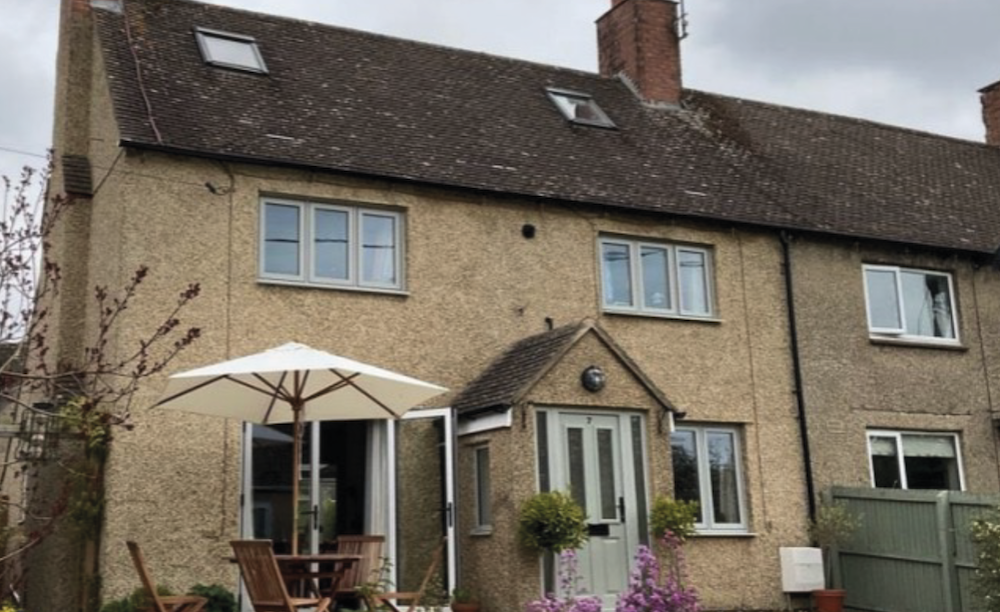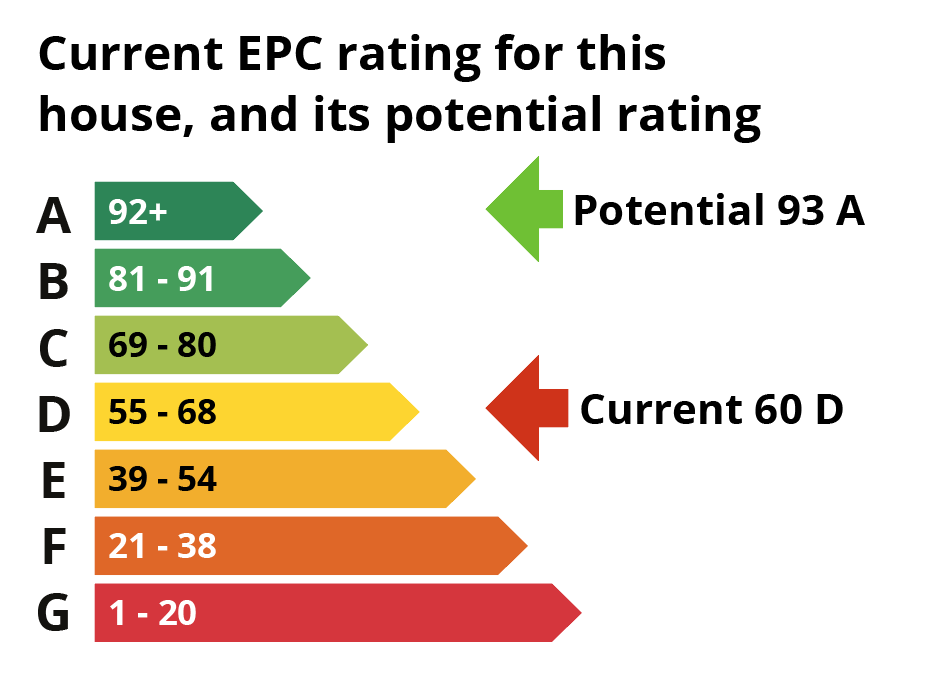
1950s semi-detached home
Could your home be made warmer, cheaper to run, and better for the planet? See what’s possible when you take a whole-home approach to planning energy upgrades.
What’s the potential of a home like this?
This 1950s semi-detached house in Charlbury is typical of post-war homes in Oxfordshire, with cavity and solid walls, a mix of timber and solid floors, and rooms in the roof.

The homeowners wanted to improve comfort without committing to a full retrofit all at once. With a Whole House Plan they were able to understand how their home worked, which upgrades mattered most, and how to plan improvements over time.
Here’s what the plan revealed:
| Carbon emissions could be cut by over 95% |
| The EPC rating could rise from 60 D to 93 A |
| Annual fuel bills could drop from around £1,911 to under £500 |
You don’t have to carry out every measure at once. The Whole House Plan gives you a roadmap so you can make improvements in your own time, at your own pace, and within your budget.

“The whole house plan helped us think completely differently about how our home worked, and helped us take steps to improving it without having to commit to a full retrofit.
It’s supported my wider understanding of the decisions people take in relation to energy efficiency.”
Alice, Charlbury
Where this home stands now
House profile
| EPC rating | Current 60 D > Potential 93 A |
| Type | Semi-detached |
| Built | 1950s |
| Location | Charlbury |
| Occupancy | Owner-occupied |
| Bedrooms | 4 |
| Floor area | 140m² |
| Walls | Cavity (unfilled) and solid |
| Floors | Suspended timber and solid |
| Roof | Pitched with rooms in roof |
| Windows | Double glazed, uPVC |
| Annual energy use | 27,241 kWh (226 kWh/m²) |
| Carbon emissions | 5.06 tonnes CO2/year |
The EPC rating: now vs potential

An EPC rates your home’s energy efficiency – from A (best) to G (worst). A higher score can mean lower bills, but it doesn’t guarantee comfort. Whole-home upgrades help bridge that gap.
Long-term comfort, short-term disruption
| Key to tables: | Low impact: • | High impact: •••••• |
| Minor measures | Comfort & health | Disruption |
|---|---|---|
| Low energy lighting | ● | ● |
| Increase loft insulation to 300mm | ●●●● | ●● |
| Insulate and draught proof loft hatch | ●●●● | ● |
| Cavity wall insulation | ●●●●● | ●● |
| New insulated front door | ●●●●● | ●● |
| Ventilation improvements | ●●●●●● | ●● |
| Major measure | Comfort & health | Disruption |
|---|---|---|
| Upgrade room-in-roof insulation | ●●●●● | ●●●●● |
| External wall insulation to cavity walls | ●●●●● | ●●● |
| Insulate suspended timber and solid floors | ●●●●● | ●●●●●● |
| New double or triple glazed uPVC windows | ●●●●●● | ●●●● |
| Air source heat pump | ●●●●●● | ●●●● |
| Measure | Comfort & health | Disruption |
|---|---|---|
| Solar PV | ● | ●● |
Expert tip

“Rooms-in-roof can suffer from overheating especially if there are skylights. We always recommend using wood fibre insulation because it’s the best material to prevent overheating. It’s also a good idea to upgrade skylights to triple glazed versions with external blinds to stop the sun’s rays penetrating on very hot days.”
Geordie Stewart, Scheme Manager
The difference each step could make
These figures show how each recommended measure could affect the home’s EPC rating, energy bills, and carbon emissions – if installed in the order shown. They’re based on a full Whole House Plan tailored to this property.
| Measure | Est. cost | EPC | Fuel bill | CO₂/year |
|---|---|---|---|---|
| Where you are now | – | 60 D | £1,911 | 5.06 t |
| Cavity wall insulation | £1.35k–£1.65k | 64 D | £1,708 | 4.46 t |
| Increase loft insulation | £1.35k–£1.8k | 67 D | £1,526 | 3.92 t |
| Insulate suspended timber floors | £9.7k–£11.8k | 70 C | £1,410 | 3.58 t |
| Ventilation improvements | £1.8k–£2.2k | 70 C | £1,410 | 3.58 t |
| Upgrade roof insulation | £2.4k–£3k | 70 C | £1,395 | 3.54 t |
| Insulate solid floor (extension) | £2.3k–£2.8k | 70 C | £1,374 | 3.47 t |
| New uPVC windows | £10.6k–£16.5k | 73 C | £1,257 | 3.12 t |
| New insulated front door | £2.1k–£2.7k | 73 C | £1,246 | 3.09 t |
| Air source heat pump | £7.5k–£12.5k | 78 C | £1,127 | 0.63 t |
| Solar PV (4 kWp) | £6.75k–£9k | 93 A | £465 | 0.17 t |
Boost your EPC rating
Installing a single major system like a heat pump or solar panels can still make a big difference. These examples show how individual upgrades could shift the home’s EPC and reduce carbon emissions – even before doing everything else.
| Upgrade option | EPC rating | Fuel bill | CO₂ emissions |
|---|---|---|---|
| Just solar PV | 85 B | £776 | 3.11 t |
| Just heat pump | 76 C | £1,258 | 0.71 t |
| Solar + heat pump | 91 B | £595 | 0.24 t |
Expert tip

“This house has suspended timber floors. Insulating them can improve the energy rating of the house and make it feel less draughty. Membranes and airtight tapes are used to create a cradle which holds flexible insulation material in place between the floor joists.”
Natasha Ginks, Retrofit Coordinator
Wondering what’s right for your home?
A Whole House Plan gives you expert, independent advice on the best steps to take – and in what order – so every upgrade really works.
Don’t put it off another year. Take the first step with a free consultation. Our team of experienced Retrofit Advisers will listen to your goals, help you understand what’s possible, and outline the best next steps – no pressure, no obligation.
Smarter home upgrades. Backed by trusted retrofit expertise.
A House Like Mine
This case study is part of A House Like Mine – a collection of real Oxfordshire homes used to model the potential of energy-saving upgrades.
Each one is based on a Whole House Plan: expert guidance on what could be done, what it might cost, and what difference it could make.
These homes haven’t had the work done – but they show what’s possible when you plan it properly.
Prefer a PDF version?
Download a shareable PDF of this case study – perfect for your community group, local class, or anyone curious about improving home energy efficiency.
We’re making this resource freely available to raise awareness of how retrofitting – upgrading your home to use less energy and stay comfortable year-round – can make a real difference.
Click here to download the PDF
